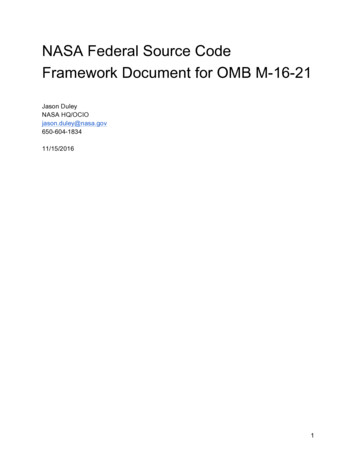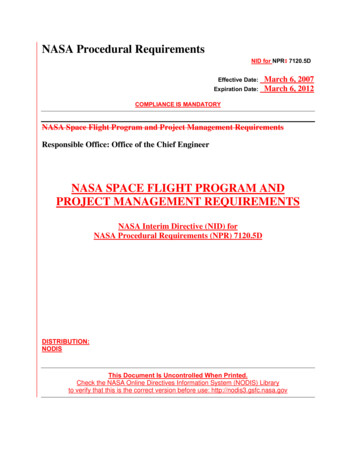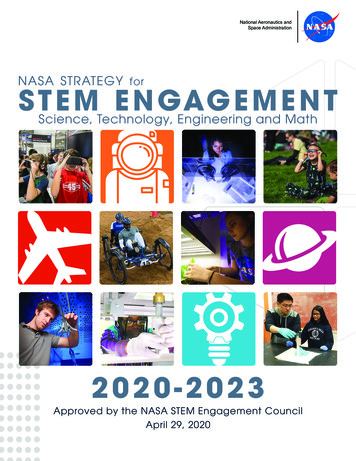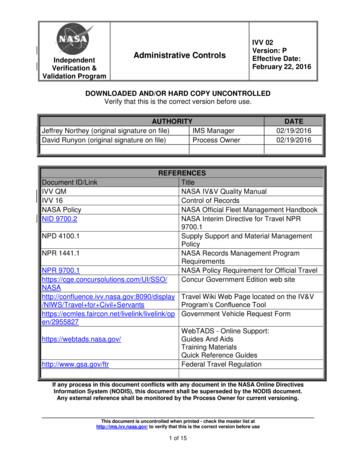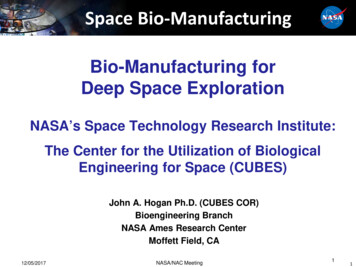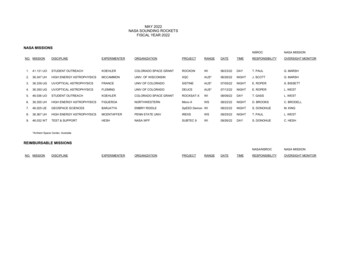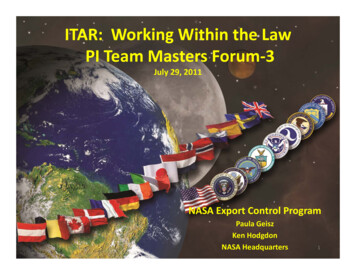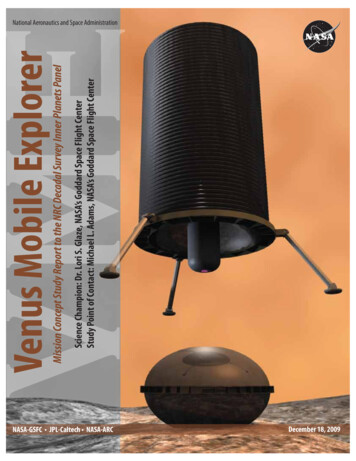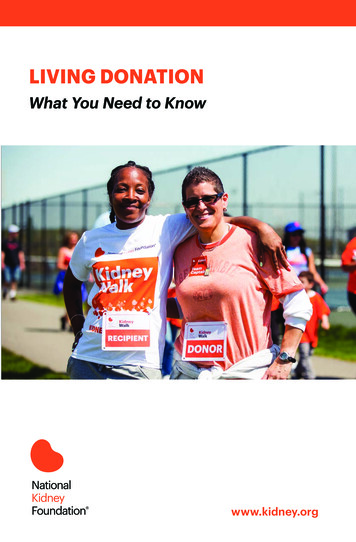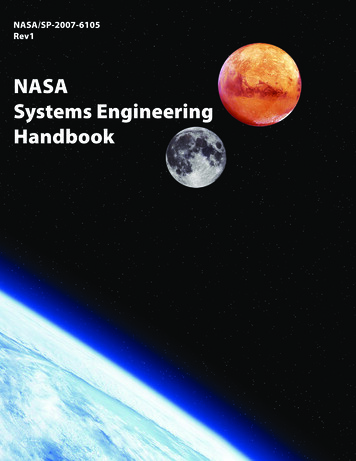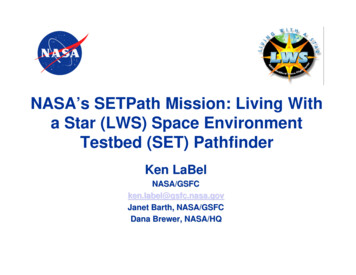
Transcription
NASA’s SETPath Mission: Living Witha Star (LWS) Space EnvironmentTestbed (SET) PathfinderKen LaBelNASA/GSFCken.label@gsfc.nasa.govJanet Barth, NASA/GSFCDana Brewer, NASA/HQ
OUTLINE What is LWS? SET Overview Implementation SETPath Implementation SummaryPresented by Ken LaBel, NASA/GSFC at the SEE Symposium in Manhattan Beach, CA on Apr 23, 20022
LWS Program ArchitectureScience with UtilityUNDERSTANDINGPresented by Ken LaBel, NASA/GSFC at the SEE Symposium in Manhattan Beach, CA on Apr 23, 20023
How Does LWS Science Reach Customers?Customer* GoalSolutionProblem Increase Capability Decrease HardwareDevelopment CostsUseNew Technologies& COTS**Systems are vulnerableto space environments.(Space Weather)Customer NeedTools to MitigateSpace Weather Effectson TechnologiesScience MissionsTMDA ProgramDefine the EnvironmentSETsDefine the ResponseInputs for ModelsInputs for ToolsSpecification, Nowcasting, ForecastingGround Test Protocol Validation, Interaction Models*NASA Missions, NASA Life Support Systems, University Smallsats ,DoD, Spacecraft Industry, Aircraft Industry** Commercial-off-the-ShelfPresented by Ken LaBel, NASA/GSFC at the SEE Symposium in Manhattan Beach, CA on Apr 23, 20024
SPACE ENVIRONMENT TESTBEDS (SET)PROJECT OBJECTIVESPerform applications research on environment interactions withinstruments & spacecraftPurpose: Improve performance & reliability and reduce costs ofinstruments & spacecraft by measuring & understandingthe effects of space weather on technologyAtmosphereUnderstandEnvironment InteractionWith Flight ComponentsPlasmaDebris &MeteoroidSpaceRadiationMicroelectronics DetectorsMaterials Spacecraft Charging/DischargingBenefits the entire scientific and aerospace community by providing much-needed early data to reduce theuncertainty in mission design, flight qualification of test methods for critical hardware & reduce missioncosts Presented by Ken LaBel, NASA/GSFC at the SEE Symposium in Manhattan Beach, CA on Apr 23, 20025
The SEE Symposium Event 2002Presented by Ken LaBel, NASA/GSFC at the SEE Symposium in Manhattan Beach, CA on Apr 23, 20026
What is SET comprised of? SET is comprised of three prime elements– The mining of existing solar-variant flight data for engineeringpurposes such as tool development Results of the first award of NASA Research Announcement(NRA) winners may be found at http://see.msfc.nasa.gov– The development of engineering infrastructure to support flightexperiments This is called a carrier or carrier-plus– Provides electrical, power, etc interfaces to experimentsas well as a central interface to the host spacecraft Correlative environment monitors (CEMs) allow in-situmeasurements versus technology performance– Flight experiments designed to investigate and/or validate solarvariant environment interaction with technology Microelectronics, photonics, sensors/detectors, materials, etc– Models, test protocols, prediction techniques, mitigative methods Provided via NRA or by partners– Experiments are not required to use the carrier if they alreadyhave flight accommodationsPresented by Ken LaBel, NASA/GSFC at the SEE Symposium in Manhattan Beach, CA on Apr 23, 20027
SET ProductsLWS/SETResearch to ReduceImpacts of Solar Variabilitye.g., Space WeatherDefine space environment effectsand mechanisms? Detector/sensor degradation andfailure mechanisms? Methods to control/eliminate plasmaeffects? Methods to control/eliminate deepdielectric charging effects? Materials degradation mechanismsand ratesImprove operational guidelines? Reduce unnecessary shutdowns? Lower the risk of anomalies? Reduce the number of failuresTest & flight validate test methods forenabling technologiesReduce design margins? Increase use of space environment“tolerant” technologies? Increase the fraction of resourcesfor payload? Reduce launch vehiclerequirements? Enable routine operations aboveLow Earth Orbit (LEO) (above 2000km) for LEO cost.? Methodologies to improvemicroelectronics performancePresented by Ken LaBel, NASA/GSFC at the SEE Symposium in Manhattan Beach, CA on Apr 23, 20028
Looking For a FewGood SET Partners! SET is a partnered program– We seek partnering at all levels (free is good!) Launch Opportunities Spacecraft Systems Engineering Support Experiments– May still have to propose via NRA– Fuller partners may not have to propose» Ex., provide a launch opportunity for free We are restricted on exchange of funds with internationalpartners, but still highly seek their contribution andparticipationAdvocacy is also highly sought (I.e., SET is a GREAT idea!)Presented by Ken LaBel, NASA/GSFC at the SEE Symposium in Manhattan Beach, CA on Apr 23, 20029
SET Schedule and Plans Periodic NRAs for data mining/toolsFlight opportunities on roughly a 2-year interval starting in2004 with SETPath– NRA for first set of SET experiments is due out by early summer– Funds experiment development, but not ground test, test methoddevelopment, etc. Experiments will have to have partnering for this portion Carrier development for first full SET mission has begun– The Johns Hopkins University/Applied Physics Laboratory (APL)and NASA/GSFC are providing core development Carrier-plus definition has begun– Partnered effort with the Defense Threat Reduction Agency(DTRA)– Currently defining requirements and architectural needs uniqueto sensor/detector technologies NASA, DTRA, Aerospace Corp, and APL are the plannedprime participantsPresented by Ken LaBel, NASA/GSFC at the SEE Symposium in Manhattan Beach, CA on Apr 23, 200210
Space Environment Testbed Pathfinder(SETPath)Objective: Collect data in space on the performanceof categories of microelectronics in thespace ionizing radiation environment Use the data to flight validate ground testprotocols and performance predictionmodels for microelectronics in the spaceionizing radiation environmentApproach: Fly slightly updated versions ofmicroelectronics testbed experiments thatwere designed for the Space Test ResearchVehicle 1-d (STRV 1-d) spacecraftCandidate Access to Space:PROBA II (ESA) testbed pendingsuccessful ESTEC proposalLaunch Vehicle: Ariane V or Indian (ESAprovided)Predicted Launch Date: May 2004Customers: Spacecraft designers– Use partnered secondary access to space– Data were not taken due to a spacecraftcommunications failureNo carrier needed: PROBA II would be carrierResults: product improvement &technology infusion performed by protocol& model developersAuthorization to proceed received from NASA HQ on 4/12/02Presented by Ken LaBel, NASA/GSFC at the SEE Symposium in Manhattan Beach, CA on Apr 23, 200211
SETPath Goals Demonstrate SET feasibility & utility for fastaccess to spaceProvide early opportunity for investigators & earlyflight data return (2004)- STRV 1-d experiments previously selected by NASA andBMDO (now MDA) Reduce risk & increase reliability for future LWSmissions- Reduce needed design margins to account for uncertaintyin the space environment & effects due to solar variabilityHelp future missions by validating guidelines &ground test protocols for microelectronic devicesin the space radiation environmentsPresented by Ken LaBel, NASA/GSFC at the SEE Symposium in Manhattan Beach, CA on Apr 23, 200212
SETPath OverviewSETPath Candidate Experiments:––––Digital COTS with FPGA Add-onOptocouplersLinear Enhanced Low Dose Rate Sensitivity (ELDRS)Linear Single Event Transients (LSET)Experiment Details Experiments were selected by a peer team for STRV1-d- STRV1-d did not return flight data due to a spacecraft communicationssystem failure- Experimenters have been contacted-Host Spacecraft/Launch: A partnered accommodations opportunityis being sought for the experiments--A partnered ESA opportunity on the PROBA II spacecraft is beingpursued with NASA as a co-Investigator- Ali Mohammadazadeh and Petteri Niemenen (ESA) are proposal coordinators- Proposal includes CNES, QinetiQ, as well as Belgian and Germanrepresentatives- Provides correlative environment data for technology experimentsOther opportunities being investigated for carrier & experiments as wellMission goal of 2 years (1 year minimum)Desired orbit is a geotransfer (GTO)- Rad hard designs required (100 krad)Presented by Ken LaBel, NASA/GSFC at the SEE Symposium in Manhattan Beach, CA on Apr 23, 200213
Space Environment Testbed Pathfinder(SETPath) Interface Requirements ConceptNASA SETPathP/LP/LPowerP/L PayloadP/LFrom onmentsMeasurementsP/LPROBA Carrier &Interface RequirementsPROBA-Provided Access to SpacePresented by Ken LaBel, NASA/GSFC at the SEE Symposium in Manhattan Beach, CA on Apr 23, 200214
Schedule Comparison: STRV-1d & SETPathSTRV-1d Electronics Testbed (ETB) ScheduleETB TaskQ1FY98Q2 Q3Q1FY02Q2 Q3Q4Q1FY99Q2 Q3Q1FY03Q2 Q3Q4Q1FY00Q2 Q3Q1FY04Q2 Q3Q4Q1FY01Q2 Q3Q1FY05Q2 Q3Flight Hardware DeliveryTestingData Analysis of TestingETB Delivery to DERAMission LaunchMission EndsFlight Data AnalysisSETPath TaskQ4Q4Q4Experiment DeliveryExpt to Carrier I&TSETPath to Host S/C I&TLaunch Site SupportMission LaunchOn-Orbit CheckoutMission Data CollectionFlight Data AnalysisPresented by Ken LaBel, NASA/GSFC at the SEE Symposium in Manhattan Beach, CA on Apr 23, 200215
SETPath:Proposed Architecture for PROBA IIDataRS-422PROBA IISpacecraftRS-42228VCommandPowerSupplies &DistributionUnit (PSDU)LSETCOTS 1PowerELDRSCOTS 2SREM*DOSETEMPCOTS 2FPGAOPTOCOTS 3* Space Radiation Effects MonitorPresented by Ken LaBel, NASA/GSFC at the SEE Symposium in Manhattan Beach, CA on Apr 23, 200216
SETPath ExperimentsExperimentNameCOTS1 LinearEnhancedLow DoseRateSensitivity(ELDRS) andSingle EventTransients(LSETS)COTS2 Digital COTSwith FPGAAdd-O nDescription?Collect data in space to validatesingle event effect (SEE) & totalionizing dose (TID) performancemodels for:?Radiation issues associated with these technologies have been noted inflight. These missions include SOHO, SAMPEX, XTE, HST, TDRS, Cassini,and others. Science data was compromised during solar events in manyinstances.– Commercial fuzzy logic processors;?In-flight anomalies have been observed on HST, TERRA, TOPEX/Poseidon,and IRIDIUM.Displacement damage portion of the experiment, for example, will helpvalidate non-ionizing energy loss models for III-V materials used inspacecraft instruments and in solar cells.?COTS3 OptocouplersNotesCollect data in space to validateELDRS and LSET performancemodels and test protocols for linearbipolar devicesThis is a two-card experiment thatexplores critical radiation-inducedissues with basic building blockdevices used in virtually every NASAand ESA design.?In-flight anomalies on missions such as GOES, TDRS, M AP, Cassini,Galileo, and SOHO have been attributed to these radiation-induced events.ELDRS is a complex issue that can not be adequately simulated or modeledvia ground irradiation only. MPTB flight experiment demonstrated theexistence of this effect, b ut did not have sufficient correlative environmentmonitoring to fully interpret the data set.– Static random access memories (SRAM); –Field programmable gate array (FPGA) logicdevices This is a two-card experimentdeveloped jointly by NASA, CNES,ONERA, and TIMA that explorestechnology models and environment tolerant approaches relevant tosystems from NASA, ESA, andCNES.Collect data in space to validatesingle event effect (SEE), totalintegrated dose (TID), and devicedisplacement damage (DDD)performance models & test protocolsfor optocouplers?- Model is also applicable to high-speed fiberoptic linksThis is a one-card experimentdeveloped by NASA on a commonbuilding block for electrical systemsthroughout NASA and ESA.Presented by Ken LaBel, NASA/GSFC at the SEE Symposium in Manhattan Beach, CA on Apr 23, 200217
SETPath Investigations:Map to Space Weather EffectsDefine Space Weather Effects on Novel fault tolerance techniques using fuzzy logic (COTS-2)?Move to on-board autonomy (Mars Rovers)Digital programmable technologies (COTS-2)?Understand effect of reduction of semiconductor feature andpower supply voltage (all NASA missions)COTS memories (COTS-2)?Understand how to reduce system data loss and increase dataintegrity (all NASA Missions)Optical technologies (COTS-3)?Resolve problems with transients (noise) and lifetimedegradation (all flight instruments)Building block technologies (linear bipolar microelectronics) (COTS-1)?Increase system reliability (long-life DoD missions)Presented by Ken LaBel, NASA/GSFC at the SEE Symposium in Manhattan Beach, CA on Apr 23, 200218
SETPath Experiments:Investigated Effects and In-FlightObservationsRadiationEffectNASA SETExperimentSingle eventeffects (SEEs)? COTS1? COTS2? COTS3Total ionizingdose (TID)Displacementdamage dose(DDD)? COTS1? COTS2? COTS3Partial list of related In-flight observations?Data loss: SOHO, XTE, GOES, SOHO, TRACE, ACE, GPSAttitude system anomalies: TERRA, GEO communications, SMM, NOAA, TDRSOperational constraints or errors: HST, MAP, TDRS, QuikSCAT, Cassini, EUVE, DE-1Increased error rates during particle events: DoD solid state recorders (SSRs), SeaStar,SOHO, GOES, multiple star trackers, SSRs, and imaging systemsSystem loss: ERS-1Premature mission failure or compromise: AMPTE/CCE, Hipparcos, GalileoObservation of microelectronics degradation: MPTBSolar cell degradation: SOHO, GEO communication satellites, Japan’s ETS-6, GOESCCD degradation: XMM, Chandra, SOHOOptocoupler failures: TOPEX/PoseidonPresented by Ken LaBel, NASA/GSFC at the SEE Symposium in Manhattan Beach, CA on Apr 23, 200219
ELDRS in Space:Microelectronics and Photonics TestBed(MPTB)This is flight data from the Microelectronics and Photonics TestBed (MPTB) for a linear device. This data illustrates the effect of true space dose rateshave when compared with traditional ground test data. The filled in circles represent the actual flight data for a device parameter (IIB) versus cumulativedose received. These data points overlay fairly nicely on the open circles which are a very lose dose rate ground test performed on this device type. Thetraditional higher dose rate ground tests (the open triangle and the square) show less damage at a given TID than the flight or low dose rate data. Thus,the traditional ground test methods would provide misleading results potentially leading to premature mission failure. Data is courtesy of NASA COTS-1experiment co-investigators at NAVSEA Crane.Presented by Ken LaBel, NASA/GSFC at the SEE Symposium in Manhattan Beach, CA on Apr 23, 200220
COTS-1:Linear Single Event Transients (LSET)Purpose Collect data in space to validatesingle event transient (SET)performance models & test protocolsfor linear bipolar devicesNASA Benefit Provide more consistent performance& lifetime; lower likelihood of LSETanomalies as observed in Cassini,MAP, & TDRSSNASA Application Linear bipolar devices are common incomparators and operationalamplifiers -- basic building blocks inall NASA spacecraft & instrumentsHistory Designed for STRV 1-d; will be builtby Aerospace CorpPartners Aerospace Corp., NASA’GSFC,NAVSEA-Crane, VanderbiltUniversity, JPL, DoD, Industry, RLPLeveraging The NASA Electronics Parts &Packaging (NEPP) and DTRAsupports development of groundradiation tests, protocols, & predictionmodels–Ground test protocol will be issued in FY2002 (Poivey/GSFC) Devices provided by industry (NSC, etal?)Development Path Modification of existing design (Koga& Crain/Aerospace Corp)Delivery Date: February 2003Risk of Schedule Slip Low; based on existing designPresented by Ken LaBel, NASA/GSFC at the SEE Symposium in Manhattan Beach, CA on Apr 23, 200221
An LSET ( Analog SET – ASET) inActionOverlayed laser data with simulation –described in a later talk at this symposiumPresented by Ken LaBel, NASA/GSFC at the SEE Symposium in Manhattan Beach, CA on Apr 23, 200222
COTS-1 LSET Products: PreliminarySETPathExperimentLinear Single EventTransient (LSET)Product(s)NASA (NEPP) and DefenseThreat Reduction Agency(DTRA) are developingguidelines for ground-basedtest protocols and predictivetechniques (FY02/03). Flightdata is used to validate theseguidelines. Guidelines will bemodified based on flightresults.Dissemination MethodsGuideline documents willbe available via NEPP (andLWS) websites ( 1 yearpost-launch).Military/industry guidelinesare being planned viaestablished test societies(JEDEC, ASTM, SPWG) –1.5 years post-launch forcommunity agreement.Further dissemination viatechnical papers atengineering conferences.Guidelines will bereferenced in GIDEP(government industry dataexchange program) lessonslearned document (AgencyAction notice) to ensureflight project notification ( 1year post-launch).Concurrent with GIDEP, thedata is fed into NASAapproved parts list (formerMil-Std-975). Modules forinclusion in industrystandard radiation codeswould be expected 2years post-launch. Datawould be available to ESAand international partnersfor inclusion in ESAguidelines.Product ResourcesData reduction: LWS NRANASA Test Guidelines:NASA NEPPPredictive Codes: NASANEPP, LWS NRAMilitary Guidelines: DTRAJEDEC Guidelines: NEPP,DTRAGIDEP Notices: NASANEPAGOther: ESAWebsites: LWS, NEPPUser ImpactProvides knowledge-base tospace systems designers,parts and radiation engineersto avoid the types of in-flightanomalies observed on MAP,TDRSS, Cassini, and HST.These types of device areused in every knownspacecraft.Presented by Ken LaBel, NASA/GSFC at the SEE Symposium in Manhattan Beach, CA on Apr 23, 200223
COTS-1:Linear Enhanced Low Dose Rate Sensitivity(ELDRS)Purpose Collect data in space to validateground test protocols for linearbipolar devices that exhibit ELDRS-ELDRS is failure at a lowercumulative total ionizing dose inspace compared to traditionalaccelerated ground test dose ratesNASA Benefit Provide more consistentperformance & lifetimeNASA Application Linear bipolar devices are commonin comparators and operationalamplifiers -- basic building blocks inall NASA spacecraft & instrumentsHistory Early experiment concept successfullyflown on MPTB by NAVSEA-Crane (SETexperiment developer)Partners NAVSEA-Crane, VanderbiltUniversity, NASA/GSFC, JPL, DoD,Industry, RLPLeveraging The NASA Electronic Parts &Packaging Program (NEPP) deliversa ground test & technology guidelinein FY 2002 (Johnston/JPL) Devices provided by industry(NSC, et al)Development Path Modification of existing design byNAVSEA-Crane (Turflinger, et al)Delivery Date: February 2003Risk of Schedule Slip Low; based on flight-heritagedesignPresented by Ken LaBel, NASA/GSFC at the SEE Symposium in Manhattan Beach, CA on Apr 23, 200224
COTS-1 ELDRS Products: PreliminarySETPathExperimentLinear EnhancedLow Dose RateSensitivity (ELDRS)Product(s)Dissemination MethodsNASA (NEPP) and DoD aredeveloping test methods toevaluate this issue on theground. Test methods haveand are being generated withno flight data. Flight data will beused to determine the accuracyof ground-based acceleratedtest methods. Products areguidelines for NASA flightprojects for testing as well asindustry/military standards.Guideline documents willbe available via NEPP andLWS websites ( 1.5 yearpost-launch).Military/industry guidelinesvia established testsocieties (JEDEC, ASTM,SPWG) will be validated ormodified – 0.5 to 2 yearspost-launch for communityagreement.Further dissemination viatechnical papers atengineering conferences.Guidelines will bereferenced in GIDEP(government industry dataexchange program) lessonslearned document (AgencyAction notice) to ensureflight project notification ( 1year post-launch).Concurrent with GIDEP, thedata is fed into NASAapproved parts list (formerMil-Std-975).Data would be available toESA and internationalpartners for inclusion inESA guidelines.Product ResourcesData reduction: LWS NRANASA Test Guidelines:NASA NEPPMilitary Guidelines: DTRA,NAVSEAJEDEC Guidelines: NEPP,DTRA, NAVSEAGIDEP Notices: NASANEPAG (NASA EEE PartsAssurance Group)Other: ESAWebsites: LWS, NEPPUser ImpactThe ELDRS issue mayimpact severely the expectedlifetime of fielded systems(premature mission failure).By having a validated testprotocol on the ground,lifetime reliability will increasesignificantly (i.e., greatlyreduced chance of prematuremission failure). These typesof device are used in everyknown spacecraft.Presented by Ken LaBel, NASA/GSFC at the SEE Symposium in Manhattan Beach, CA on Apr 23, 200225
COTS-2:Digital COTSPurpose Collect data in space to validatesingle event effect (SEE) & totalionizing dose (TID) performancemodels for:–––Commercial fuzzy logic processors;Static random access memories(SRAM); &Field programmable gate array(FPGA) logic devicesNASA Benefit Reduce design margins &provide more consistentperformance in spaceNASA Application Partners NASA/GSFC, CNES, ONERA, TIMADevelopment Path Modification to existing STRV 1-d flightcard for PROBA II interface (NASA/GSFC)Delivery Date: February 2003Risk of Schedule Slip Low; existing hardwareGround data availability Heavy ion & proton data in handfrom Orsay, FranceHistory: Built for STRV 1-d but not flownFuzzy logic: Robotics, docking, &constellation managementapplicationsSRAMS: Solid state recordersFPGAs: Replace custom solutionsPresented by Ken LaBel, NASA/GSFC at the SEE Symposium in Manhattan Beach, CA on Apr 23, 200226
COTS-2:FPGA Technology Concept ValidationPurpose Collect data in space to validate singleevent effect (SEE) and total ionizingdose (TID) performance models & testprotocols for COTS and environmenthardened FPGAsNASA Benefit Provide more consistent performancein spacecraft electronics systems.NASA Application Replace custom solutions inelectronics system design at a fractionof the cost in virtually all NASAspacecraft; save power, weight,volume, & scheduleHistory Designed for STRV 1-d byNASA/GSFC; devices will be updatedto state of the artPartners NASA/GSFC, DoD, Industry, (is TIMAinterested?)Leveraging The NASA Electronics Parts &Packaging Program supportsdevelopment of ground test protocols,guidelines, & technology development Devices provided by DoD & industryDevelopment Path Existing design (Katz - NASA/GSFC)with mission-specific modificationsDelivery Date February 2003Risk of Schedule Slip Low – existing design withexperienced flight designerPresented by Ken LaBel, NASA/GSFC at the SEE Symposium in Manhattan Beach, CA on Apr 23, 200227
COTS-2 Products: PreliminarySETPathExperimentDigital COTSwith ourcesUser ImpactThe internationalcollaboration for thisexperiment (NASA,CNES, et al) provides awide-base for productdevelopment. Reports willbe developed comparingand contrasting the faulttolerance techniques, aswell as the variousdiffering radiation-inducedperformances bycommercial and hardenedoptions. The data will feedinto the development oflessons learned fordevelopment of moderndigital electronic systemsas well as novel faulttolerant techniques.Guideline documentswill be developed byNASA and partners forreliable technologyinsertion into flightprojects ( 1.5 yearspost-launch).Investigators at NASAand CNES routinelyteach classes at theirrespectiveorganizations ondesign techniques.This data will beincluded to ensureimproved flight projectperformance andreliability. All guidelinesand documents will beavailable on NEPP andLWS websites.Data reduction: LWSNRATechnologyGuidelines: NASANEPP, CNESWebsites: LWS, NEPPDigital designersroutinely use thememory and FPGAtechnologies consideredby this experiment.Reliable design methodsvalidated here provide amethod of safelyreducing cost andschedule to flightprojects. Fuzzy logictechniques yieldpotential direct benefitsto robotics (rovers),autonomous docking,etc.Presented by Ken LaBel, NASA/GSFC at the SEE Symposium in Manhattan Beach, CA on Apr 23, 200228
COTS-3:OptocouplersPurpose Collect data in space to validatesingle event effect (SEE), totalionizing dose (TID), and devicedisplacement damage (DDD)performance models & testprotocols for optocouplers-Portions of the models may also beapplicable to high-speed fiber opticlinksNASA Benefit Reduce design margins &increase reliability-Anomalies on HST, TERRA, &TOPEX/Poseidon)NASA Application Used to isolate electrical signalsbetween spacecraft sub-systems &instruments; ex., power convertersHistory Designed for STRV- 1d byNASA/GSFC; new optocouplers willbe utilized for SETPathPartners NASA GSFC, JPL, DoD, IndustryLeveraging The NASA Electronic Parts &Packaging Program (NEPP) andDTRA deliver a ground test &technology guideline in FY 2002(Reed/GSFC) Devices provided by industryDevelopment Path Existing design; mission-specificinterface modifications & newerdevices (Buchner – GSFC)Delivery Date: February 2003Risk of Schedule Slip: Low; basedon an existing designGround data availability Heavy ion & proton data in hand;all new ground data to be fundedby NEPPPresented by Ken LaBel, NASA/GSFC at the SEE Symposium in Manhattan Beach, CA on Apr 23, 200229
Optocoupler SETs –Unlike Traditional Si Microelectronicsip L maxProton ionizationtracks or reactionrecoils generatecharge in detectors.This “0” is“1” is not This “0” may corruptedcorrupted be corruptedi1i thi0Decision PointsTimePresented by Ken LaBel, NASA/GSFC at the SEE Symposium in Manhattan Beach, CA on Apr 23, 200230
COTS-3 Optocoupler roduct(s)Dissemination MethodsProduct ResourcesUser ImpactNASA (NEPP) and DTRAhave partnered to developmodels for radiation effectson optocouplers as well astest methods and predictivetechniques. This is a newmethod not traditionallyused with “standard”integrated circuits. A firstmethod for bounding theissue based on no flight data(order of magnitude) will bereleased in FY02. Thisprecision may limit scienceinstrument and spacecraftsubsystem operationcapabilities and lifetimes.Flight data will validate orprovide critical input toreduce design margins inthis method.Guideline documents willbe available via NEPP(and LWS) websites ( 1year post-launch).Further dissemination viatechnical papers atengineering conferences.Guidelines will bereferenced in GIDEP(government industrydata exchange program)lessons learneddocument (AgencyAction notice) to ensureflight project notification( 1 year post-launch).Concurrent with GIDEP,the data is fed into NASAapproved parts list(former Mil-Std-975).Data would be availableto ESA and internationalpartners for inclusion inESA guidelines.Data reduction: LWSNRANASA Test andTechnology Guidelines:NASA NEPPPredictive Codes: NASANEPP, LWS NRAMilitary Guidelines:DTRAJEDEC Guidelines:NEPP, DTRAGIDEP Notices: NASANEPAGOther: ESAWebsites: LWS, NEPPProvides knowledge-baseto space systemsdesigners, parts andradiation engineers toavoid the types of in-flightanomalies observed onHST, Cassini, and Terra(and Iridium). These typesof device are used invirtually every knownspacecraft.Presented by Ken LaBel, NASA/GSFC at the SEE Symposium in Manhattan Beach, CA on Apr 23, 200231
General SETPathExperiment Specifications With the exception of the existing COTS-2 card, all SETPathexperiment cards will have the following generalcharacteristics:– Conform to Eurocard 3U form factor (10cmx16cm)– Weigh 250g when populated– Draw between 2.5 W (LSET, FPGA, Optocoupler) and 4 W (ELDRS) whenactive Mission power profile dictates that no more than 5W of power bedrawn from SETPath experiments at one time SEE experiments will alternate orbits– ELDRS will be biased ( 500 mW) during all other SETPathexperiment active times, then read 1X per orbit– Have a ESAPMOS4 dosimeter and AD590 temperature sensor Read by SREM from each SETPath experiment– Cumulative data rate of SETPath experiments of 50 bits/sec maximum Electrical interface is ESA standard: TTC-B-01– PROBA II will have panel cutouts for experiment cardsPresented by Ken LaBel, NASA/GSFC at the SEE Symposium in Manhattan Beach, CA on Apr 23, 200232
SETPath Power ProfilePreliminaryExperiment 5V-5VLSET0.1Optocoupler0.41ELDRS0.11Digital COTS0.075FPGA0.15 15V-15V 3.3V l Icc in A0.02 0.8450.2080.1630.7Power in W2.5252.54.1450.4652.565012.2Experiments will be power-switched due to operationalconstraints (5W)The voltages listed above are those that are being plannedfor support by the full SET Carrier (non-SETPath)– We are considering providing only a subset for SETPath 5V, /- 15V PSDU will be 2 cards (Eurocard 3U) and weigh 500g– Shielding may be required to meet 100 krad design goalPresented by Ken LaBel, NASA/GSFC at the SEE Symposium in Manhattan Beach, CA on Apr 23, 200233
SETPathRoles & Responsibilities Mission Management: GSFC LWS Experiments: GSFC (in-house build),NAVSEA/CRANE, and Aerospace Corporation Carrier (I.e., PSDU): APL build Experiment-to-carrier integration & test: At GSFCjointly with APL & experimenter support SETPath-to-Host Spacecraft Integration and test:At Host Spacecraft provider with APL & GSFCsupportPresented by Ken LaBel, NASA/GSFC at the SEE Symposium in Manhattan Beach, CA on Apr 23, 200234
SETPathSummary Comments Experiments were peer selected using a community consensus– Experimenters were contacted & are ready to proceed Carrier conceptual design has been started at APL– Modular design approach permits it to be used for SETPath (if needed) and/orSET-1 Host spacecraft has been identified & preliminary discussions areunderway (PROBA II)– 1st proposal due April 29th, 2002– Alternatives exist and under investigation GSFC LWS Mission manager has been assigned (Ken LaBel)– SETPath units will be treated in the same manner as Shuttle experiments;limited formal review requirements Detailed schedule has been developedSETPath will return critical flight data to reduce the risk & cost offuture LWS & other NASA missionshttp://lws-set.gsfc.nasa.govPresented by Ken LaBel, NASA/GS
LWS/SET Research to Reduce Impacts of Solar Variability e.g., Space Weather Test & flight validate test methods for enabling technologies. 9 Presented by Ken LaBel, NASA/GSFC at the SEE Symposium in Manhattan Beach, CA on Apr 23, 2002 Looking For a Few Good SET Partners!
